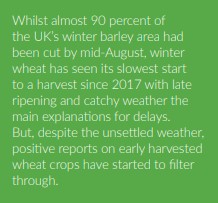Written by Keith Nicholson
Despite catchy August weather that has left many farmers with the usual harvest headaches there have been some notable performances from several new varieties being grown for the first time, including two new winter barley varieties, that have exceeded the current AHDB winter barley yield estimates of 6.8-7.2t/ha reported to date for 2021 harvested crops

Tim Booth, Lincolnshire Farmer
near Swinehead
Tim grew a crop of Lightning with a yield of just over 8.6t/ha, a new 2-row conventional winter feed barley from breeder Elsoms Seeds. It’s our first-time growing winter barley as historically, its been tricky to fit into our rotation. However, we changed things up last autumn, drilled 17ha and were rewarded with a fantastic looking crop that had no disease issues, all beit in a low-pressure year for this area. Beyond 1 or 2 minor lodging problems due to heavy rains Lightning competed well producing a lot of tillers which smothered the ground very quickly helping to keep our blackgrass at bay. It’s an early maturing type that proved excellent for an early harvest slot as we followed it with oilseed rape drilled on August 2nd.
Although not really tested it has 8s for Rhynchosporium and net blotch and 7s for mildew and brown rust, so the disease package looks potentially very solid” he confirms.

Tony Scarborough, farmer near
Grantham
Tony grew a first-time crop of winter barley Bolton harvested on August 9th and achieved almost 8t/ha, again well above AHDB national yield estimates for this season. We drilled on October 12th in decent weather. The variety established quickly, competing extremely well. It stood well during the spring, despite some heavy rain that temporarily yellowed the crop, and received a basic fungicide package at T1 with a more robust spray at T2 on May 12th. Bolton looks a good variety for a mixed farm, proving uncomplicated to grow and producing a significant quantity of good quality stiff straw. We grew two winter barleys this season, including Hawking from breeder KWS which did 6.78t/ha, although both varieties were drilled at the same time and received the same inputs package.
The final bushel weight of 63hL on the Bolton was slightly down on our farm average of 65hL, although that seems to be in line with AHDB reports of national averages of 60-64hL for winter barley this year” adds Tony.

John Wilson, Rankeilour Farms
near Cupar in Fife
Reports on Bolton have also been positive further north where John drilled 17.6ha of the crop on 15th16th of September. Weather conditions at and post drilling were excellent, and the crop was at the 4-5 tiller stage going into winter. A low-pressure disease year was further aided by a cold snap in early spring so, despite not being fully tested, it did cope extremely well with the very heavy rain we caught in May. Harvested in early August the final yield was an impressive 10.56t/ha, ahead of our 5-year farm average. Specific weight was 68hL, again better than expected and excellent for a feed barley.
Although not really examined on its disease resistance this year Bolton was easy to grow, stood well and looks a straightforward robust variety

Tony Bell, farmer near Thirsk
For Tony a first-time crop of the Group 4 hard wheat Astound achieved a yield of almost 10t/ha supporting its credentials as a robust, low stress variety. We drilled 18ha of Astound, split across 2 fields, with the larger field late sown on November 5th following a ‘difficult to harvest’ crop of maize. Despite heavy rain that submerged parts of the crop, it came through and established extremely well once the land had dried, displaying excellent early vigour. We went with Astound based on its high untreated yield and a relatively high treated yield and to achieve nearly 10t/ha following late drilling, just a modest fungicide package and the very challenging weather conditions it endured was a very positive result overall. Grain quality was excellent, and, in better growing conditions with earlier establishment, I feel that it’s a variety capable of challenging the highest yielding winter wheats we’ve grown in recent years.
George Renner, farmer in Leicestershire
Further south George Renner achieved 9.2t/ha on a crop of Group 3 soft wheat Merit, a new variety to the recommended list that can be used for biscuit making, distilling and for export. We eventually drilled during the 4th week of October, later than desired due to adverse weather and, despite not being in a particularly high risk septoria area, we took no chances applying a robust fungicide strategy. The crop stood well and coped well with the weather thrown at it and, whilst I was satisfied with 9.2t/ha, the potential for a much higher yield was lost during a 6 week dry spell in late April and May which was then followed by a dull June. It’s uncomplicated to grow and with premiums available alongside good marketability I would certainly recommend it

Kit Papworth, farmer near North Walsham in
north-east Norfolk
We grew 14ha of Merit as a seed crop this time to get a feel for it, late drilled in the second week of December following sugar beet. As with most late drilled crops it was slow to emerge before racing through its growth stages the following spring. Tillering nicely, the crop received a robust fungicide programme to combat significant late yellow rust and septoria outbreaks in late May and we were rewarded with a clean crop that should yield over 9t/ha.
Having budgeted the crop at 8.5t/ha it’s a good overall result, however looking ahead to next year, on better fields and with an earlier drilling slot, I’d hope we’d be able to easily achieve 10t/ha as a commercial crop. Merit offers growers a range of marketing options, we’re too far from a mill, so the attraction for us would be to grow for export, given our close proximity to the deep-water port of Great Yarmouth and Merit’s UKS approval for soft milling export